Extended Short-Time Fourier Transform for Ultrasonic Velocity Profiler on Two-Phase Bubbly Flow Using a Single Resonant Frequency
Abstract
:1. Introduction
2. Materials and Methods
2.1. The UVP with Doppler Pulse Repetition Technique
 where φ is the initial phase of the in-phase signals XI and the quadrature-phase signals XQ.
where φ is the initial phase of the in-phase signals XI and the quadrature-phase signals XQ.2.2. The Behavior of the Doppler Signal in Two-Phase Bubbly Flow
2.3. Phase-Separation Technique
3. Experimental Setup
3.1. Experimental Apparatus
3.2. Experimental Conditions and Procedure
4. Results and Discussion
4.1. Velocity Profile Measurement at Single-Phase Flow
4.2. Doppler Amplitude Threshold Setting
4.3. Velocity Profile Measurement at Two-phase Bubbly Flow
4.3.1. Measurement and Comparison
4.3.2. Measurement at a Different Void Fraction
4.4. Error Analysis
5. Conclusions
- -
- Instantaneous velocity profile of liquid and bubble can be obtained simultaneously.
- -
- The velocity profile of liquid and bubble can be separately obtained even if the velocity data of both phases occur in the same measurement channel.
- -
- The developed phase separation can distinguish the velocity of both phases, although similarities occur with both phases.
- -
- The system requires only a single resonant frequency transducer, a single channel pulser/receiver, and basic data processing equipment.
Author Contributions
Acknowledgments
Conflicts of Interest
References
- Ishii, M.; Hibiki, T. Thermo-Fluid Dynamics of Two-Phase Flow; Springer: New York, NY, USA, 2012. [Google Scholar]
- Ozaki, T.; Suzuki, R.; Mashiko, H.; Hibiki, T. Development of drift-flux model based on 8 × 8 BWR rod bundle geometry experiments under prototypic temperature and pressure conditions. J. Nucl. Sci. Technol. 2013, 50, 563–580. [Google Scholar] [CrossRef] [Green Version]
- Wang, G.; Ching, C.Y. Measurement of multiple gas-bubble velocities in gas-liquid flows using hot-film anemometry. Exp. Fluids 2001, 31, 428–439. [Google Scholar] [CrossRef]
- Wu, Q.; Ishii, M. Sensitivity study on double-sensor conductivity probe for the measurement of interfacial area concentration in bubbly flow. Int. J. Multiph. Flow 1999, 25, 155–173. [Google Scholar] [CrossRef]
- Muñoz-Cobo, J.L.; Chiva, S. Development of Conductivity Sensors for Multi-Phase Flow Local Measurements at the Polytechnic University of Valencia (UPV) and University Jaume I of Castellon (UJI). Sensors 2017, 17, 1077. [Google Scholar] [CrossRef] [PubMed]
- Albrecht, H.E.; Borys, M.; Damaschke, N.; Tropea, C. Laser Doppler and Phase Doppler Measurements Techniques; Springer: Berlin/Heidelberg, Germany, 2003. [Google Scholar]
- Chen, R.C.; Fan, L.S. Particle image velocimetry for characterizing the flow structure in three- dimensional gas-liquid-solid fluidized beds. Chem. Eng. Sci. 1992, 47, 3615–3622. [Google Scholar] [CrossRef]
- Lindken, R.; Merzkirch, W. Velocity measurements of liquid and gaseous phase for a system of bubbles rising in water. Exp. Fluids 2000, 29, 194–201. [Google Scholar] [CrossRef]
- Takeda, Y. Velocity profile measurement by ultrasonic Doppler shift method. Int. J. Heat Fluid Flow 2008, 7, 313–318. [Google Scholar] [CrossRef]
- Aritomi, M.; Zhou, S.; Nakajima, M.; Takeda, Y.; Mori, M.; Yoshioka, Y. Measurement system of bubbly flow using ultrasonic velocity profile monitor and video data processing unit. J. Nucl. Sci. Technol. 1996, 33, 915–923. [Google Scholar] [CrossRef]
- Aritomi, M.; Zhou, S.; Nakajima, M.; Takeda, Y.; Mori, M.; Yoshioka, Y. Measurement system of bubbly flow using ultrasonic velocity profile monitor and video data processing unit (II) Flow characteristic of bubbly counter current flow. J. Nucl. Sci. Technol. 1997, 34, 783–791. [Google Scholar] [CrossRef]
- Zhou, S.; Suzuki, Y.; Aritomi, M.; Matsuzaki, M.; Takeda, Y.; Mori, M. Measurement system of bubbly flow using ultrasonic velocity profile monitor and video data processing unit (III) Comparison of flow characteristics between bubbly current and counter current flow. J. Nucl. Sci. Technol. 1998, 35, 335–343. [Google Scholar] [CrossRef]
- Suzuki, Y.; Nakagawa, M.; Aritomi, M.; Murakawa, H.; Kikura, H.; Mori, M. Microstructure of the flow field around a bubble in counter-current bubbly flow. Exp. Therm. Fluid Sci. 2002, 26, 221–227. [Google Scholar] [CrossRef]
- Yamanaka, G.; Murakawa, H.; Kikura, H.; Aritomi, M. The novel velocity profile measuring method in bubbly flows using ultrasound pulses. In Proceedings of the 7th International Symposium on Fluid Control, Measurement and Visualization, Sorento, Italy, 25–28 August 2003; pp. 214–217. [Google Scholar]
- Murakawa, H.; Kikura, H.; Aritomi, M. Application of ultrasonic multi-wave method for two-phase bubbly and slug flow. Flow Meas. Instrum. 2008, 19, 205–213. [Google Scholar] [CrossRef]
- Nguyen, T.; Murakawa, H.; Tsuzuki, N.; Kikura, H. Development of multi-wave method using ultrasonic pulse. J. Jpn. Soc. Exp. Mech. 2013, 13, 277–284. [Google Scholar]
- Murai, Y.; Tasaka, Y.; Nambu, Y.; Takeda, Y.; Gonzalez, S.R. Ultrasonic detection of moving interfaces in gas-liquid two-phase flow. Flow Meas. Instrum. J. 2010, 21, 356–366. [Google Scholar] [CrossRef]
- Wongsaroj, W.; Hamdani, A.; Thong-un, N.; Takahashi, H.; Kikura, H. Ultrasonic Measurement of Velocity Profile on Two-phase bubbly flow Using Fast Fourier Transform (FFT) Technique. IOP Conf. Ser. Mater. Sci. Eng. 2017, 249, 012011. [Google Scholar] [CrossRef]
- Wongsaroj, W.; Hamdani, A.; Thong-un, N.; Takahashi, H.; Kikura, H. Ultrasonic Measurement of Velocity Profile on Two-phase bubbly flow Using a Single Resonant Frequency. Proceedings 2018, 2, 549. [Google Scholar] [CrossRef]
- Sharma, G.K.; Kumar, A.; Rao, C.B.; Jayakumar, T.; Raj, B. Short time Fourier transform analysis for understanding frequency dependent attenuation in austenitic stainless steel. NDT E Int. 2013, 53, 1–7. [Google Scholar] [CrossRef]
- Valérie, R.; Melania, S.; Gérard, L. Step Length Estimation Using Handheld Inertial Sensors. Sensors 2012, 12, 8507–8525. [Google Scholar] [Green Version]
- Baba, T. Time-Frequency Analysis Using Short Time Fourier Transform. Open Acoust. J. 2012, 5, 32–38. [Google Scholar] [CrossRef]
- Murakawa, H.; Sugimoto, K.; Takenaka, N. Effects of the number of pulse repetitions and noise on the velocity data from the ultrasonic pulsed Doppler method with different algorithms. Flow Meas. Instrum. 2014, 40, 9–18. [Google Scholar] [CrossRef]
- Kasai, C.; Namekawa, K.; Koyano, A.; Omoto, R. Real-time Two-dimensional Blood Flow Imaging Using an Autocorrelation Technique. IEEE Trans. Sonic Ultrason. 1985, 32, 458–464. [Google Scholar] [CrossRef]
- Qian, S.; Rao, Y.; Chen, D. A fast Gabor spectrogram. In Proceedings of the IEEE International Conference on Acoustics, Speech, and Signal Processing, Istanbul, Turkey, 2–6 August 2002; pp. 653–656. [Google Scholar]
- Yufeng, L.; In, S.A. Comparison of Time Frequency Analysis Techniques for Ultrasonic NDE Signal. In Proceedings of the IEEE International Conference on Electro/Information Technology, Mankato, MN, USA, 15–17 May 2011. [Google Scholar]
- Treenuson, W.; Tsuzuki, N.; Kikura, H.; Wada, S.; Tezuka, K. Accurate Flowrate Measurement on the Double Bent Pipe using Ultrasonic Velocity Profile Method. Exp. Mech. 2013, 13, 200–211. [Google Scholar]
- Weisman, J.; Duncan, D.; Gibson, J.; Crawford, T. Effects of fluid properties and pipe diameter on two-phase flow patterns in horizontal lines. Int. J. Multiph. Flow 1979, 5, 437–462. [Google Scholar] [CrossRef]
- Wu, T.Y.; Guo, N.; Teh, C.Y.; Hay, J.X.W. Advances in Ultrasound Technology for Environmental Remediation; Springer: Dordrecht, The Netherlands, 2013. [Google Scholar]
- Shi, W.; Yang, J.; Li, G.; Yang, X.; Zong, Y.; Cai, X. Modelling of breakage rate and bubble size distribution in bubble columns accounting for bubble shape variations. Chem. Eng. Sci. 2018, 187, 391–405. [Google Scholar] [CrossRef]
- Guédon, G.R.; Besagni, G.; Inzoli, F. Prediction of gas–liquid flow in an annular gap bubble column using a bi-dispersed Eulerian model. Chem. Eng. Sci. 2017, 161, 138–150. [Google Scholar] [CrossRef] [Green Version]
- Takeda, Y. Ultrasonic Doppler Velocity Profiler for Fluid Flow; Springer: Tokyo, Japan, 2012. [Google Scholar]
- Kikura, H.; Yamanaka, G.; Aritomi, M. Effect of measurement volume size on turbulent flow measurement using ultrasonic Doppler method. Exp. Fluids 2004, 36, 187–196. [Google Scholar] [CrossRef]
- Besagni, G.; Inzoli, F. Bubble size distributions and shapes in annular gap bubble column. Exp. Therm. Fluid Sci. 2016, 74, 27–48. [Google Scholar] [CrossRef] [Green Version]

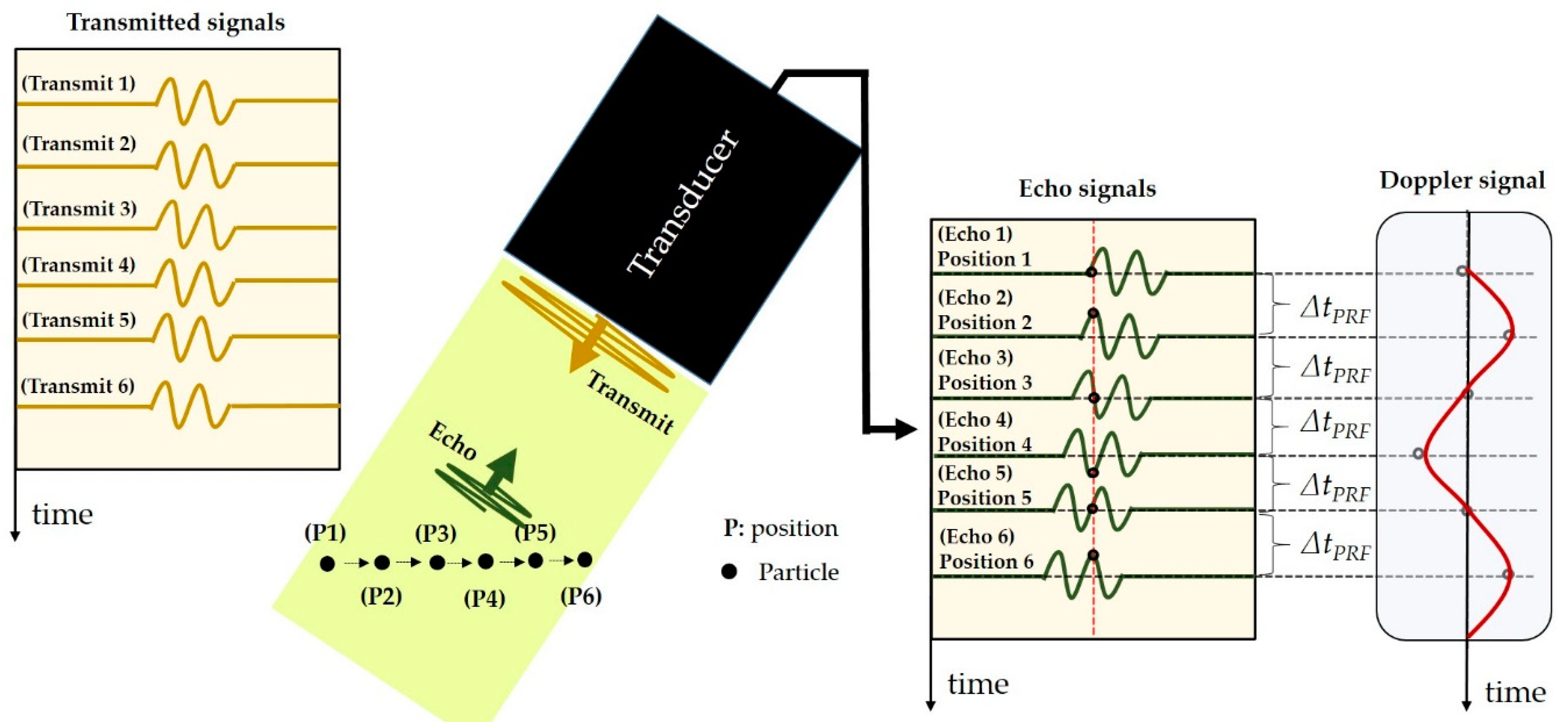

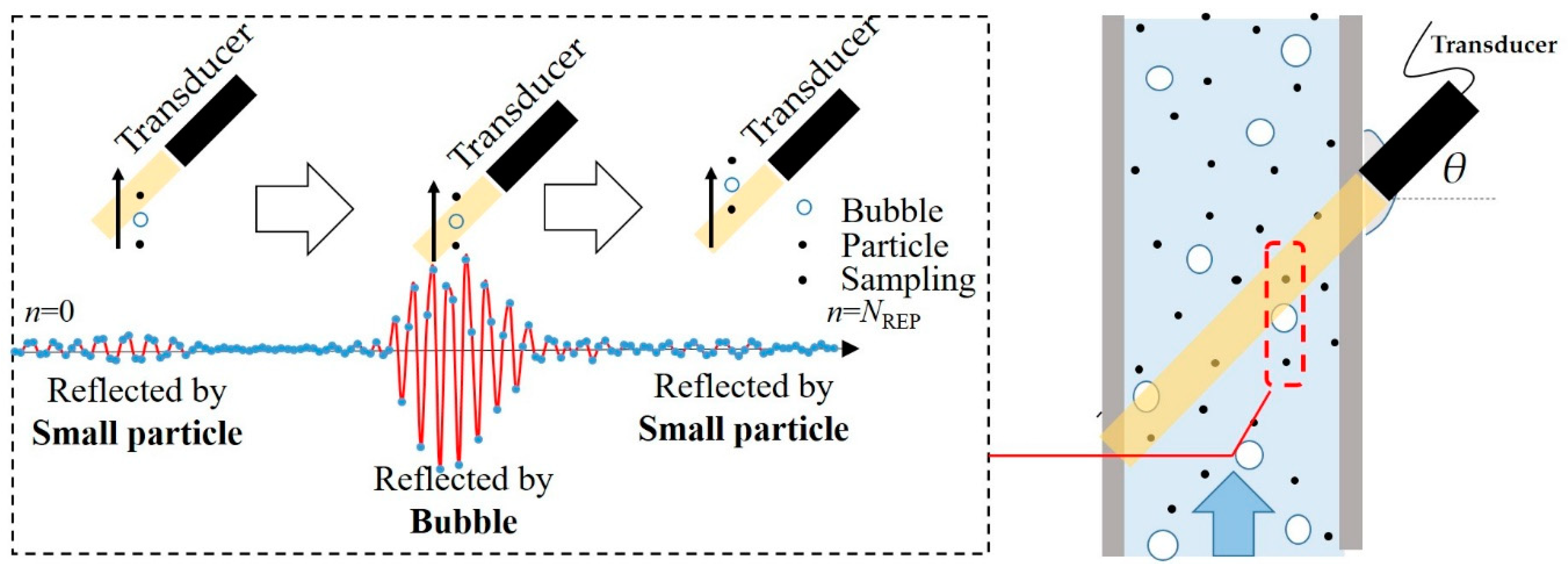

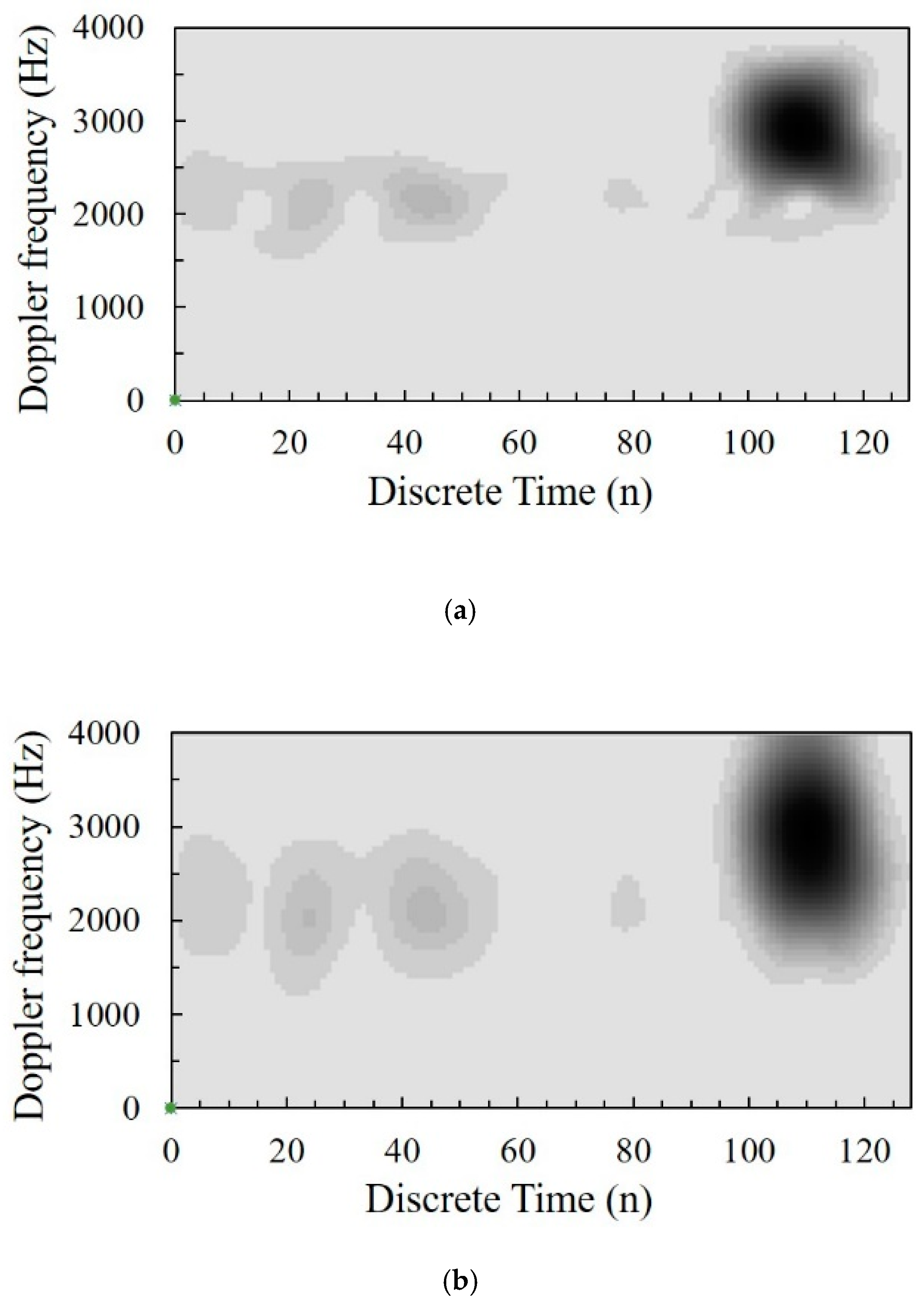

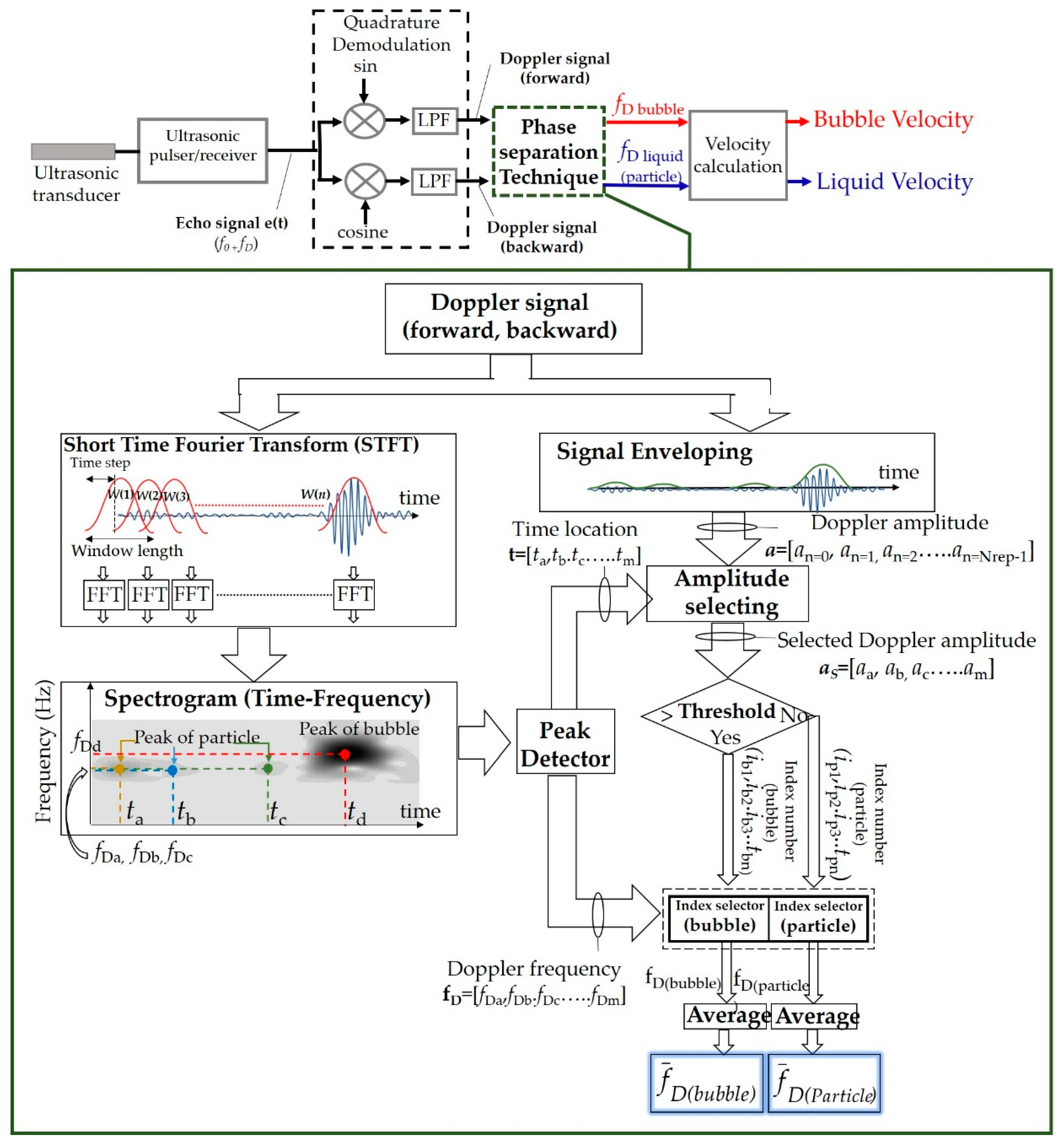

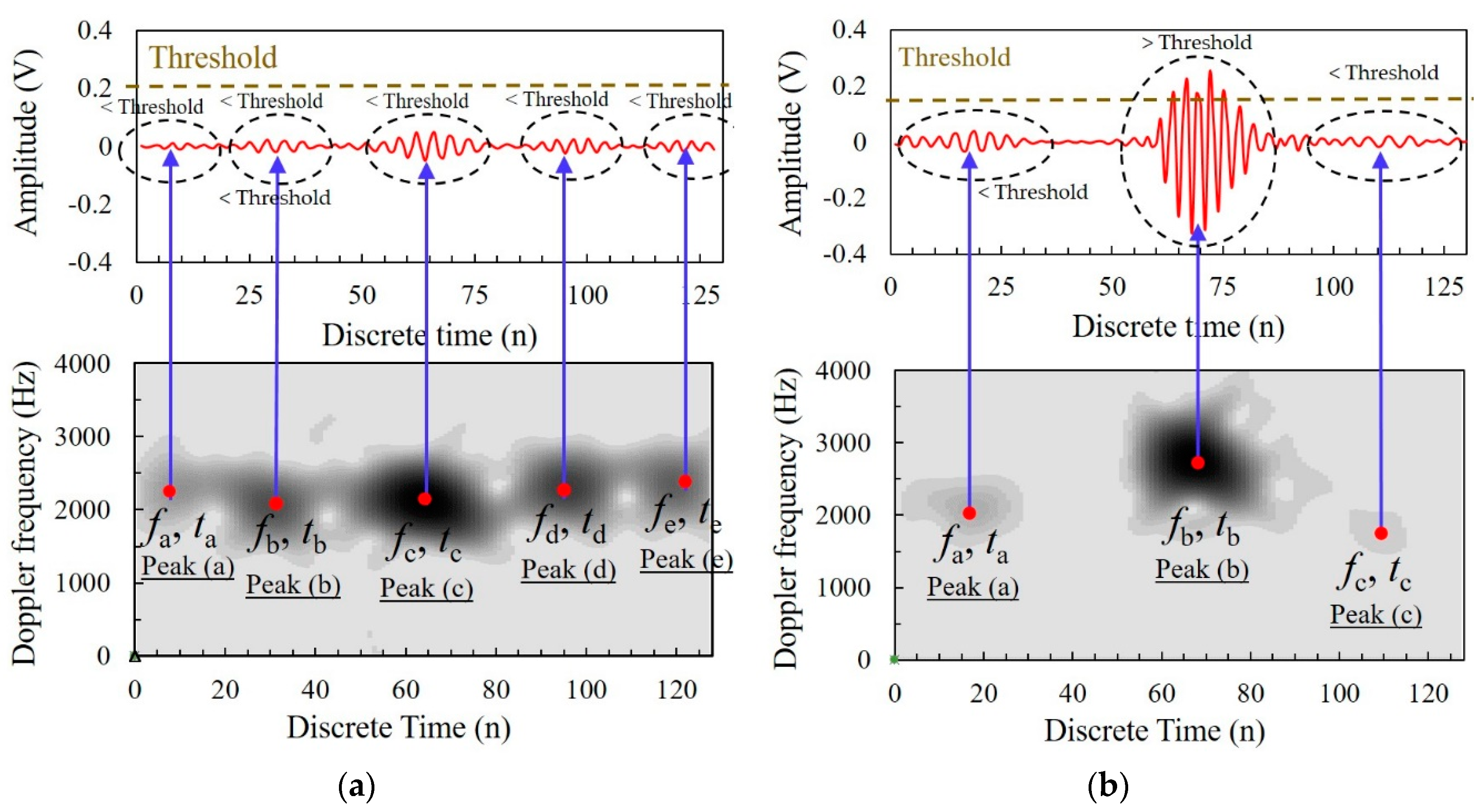
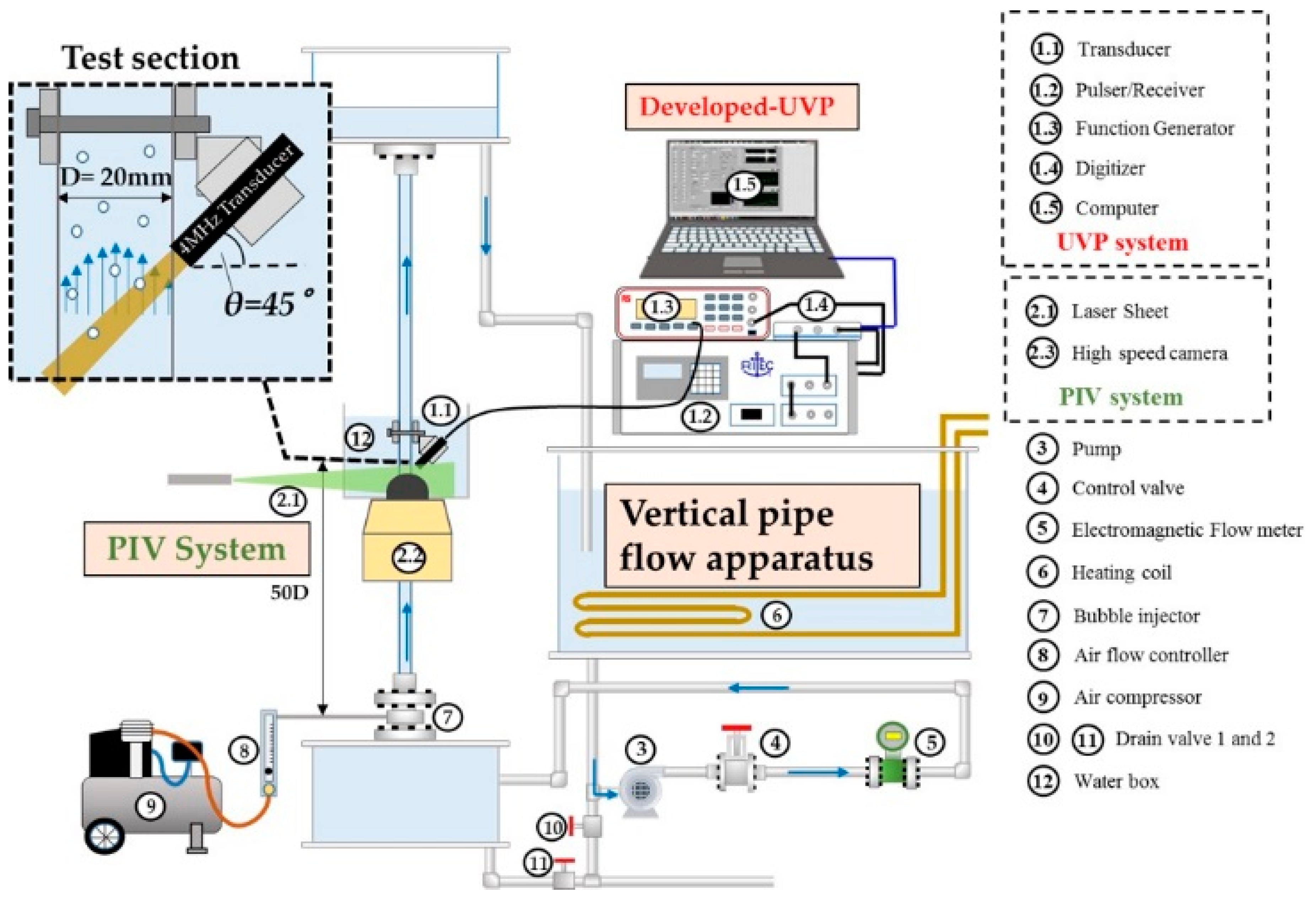
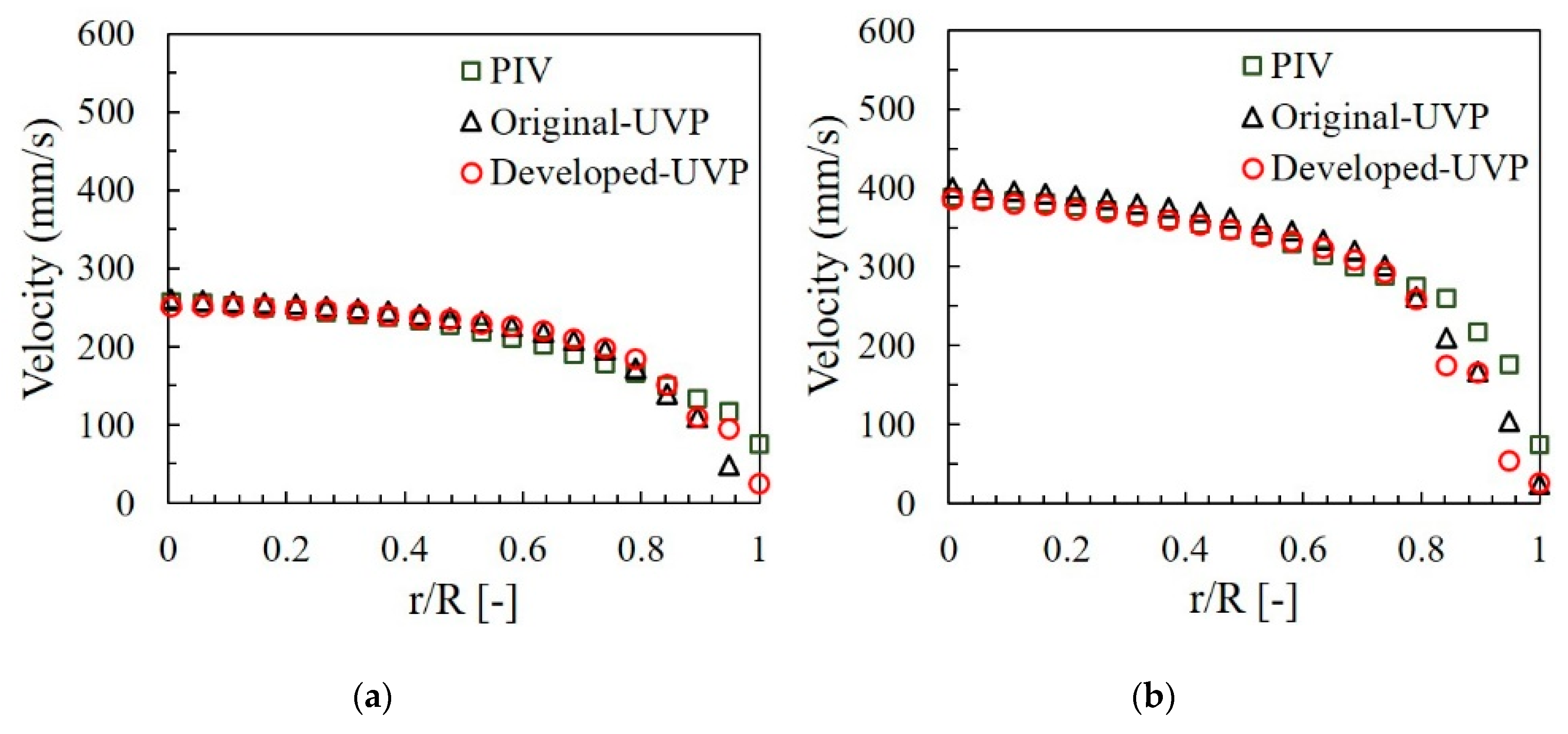

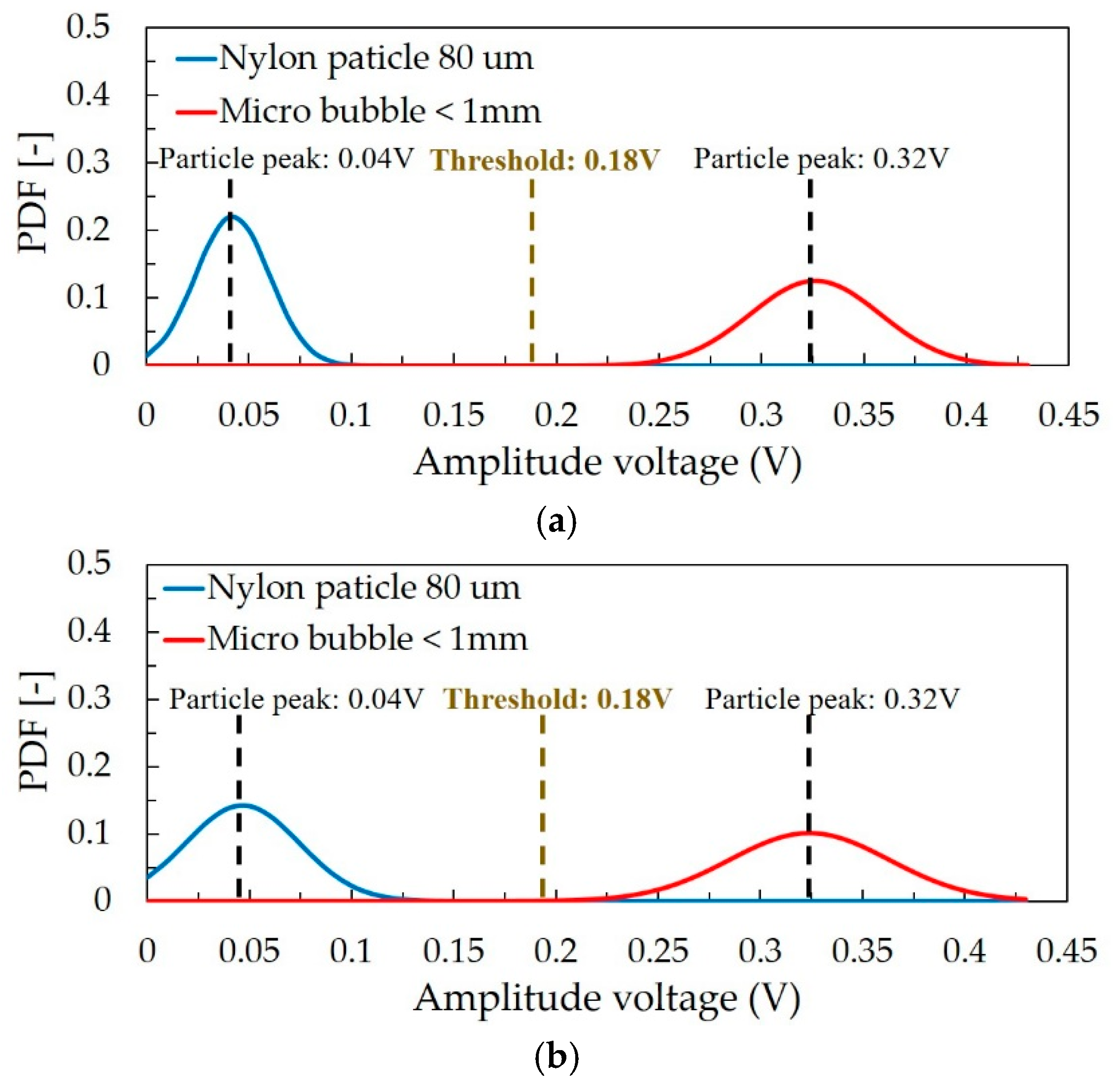

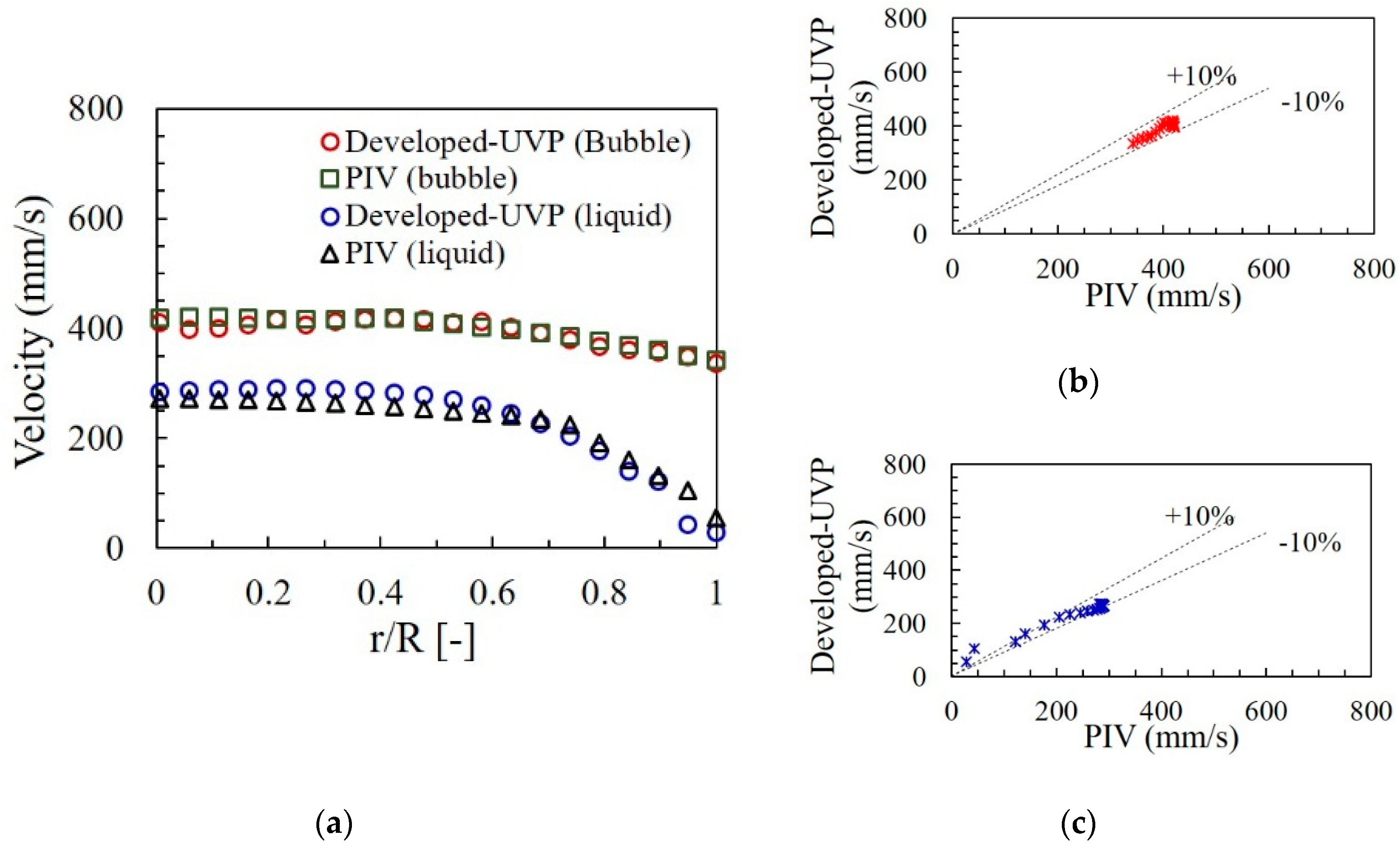
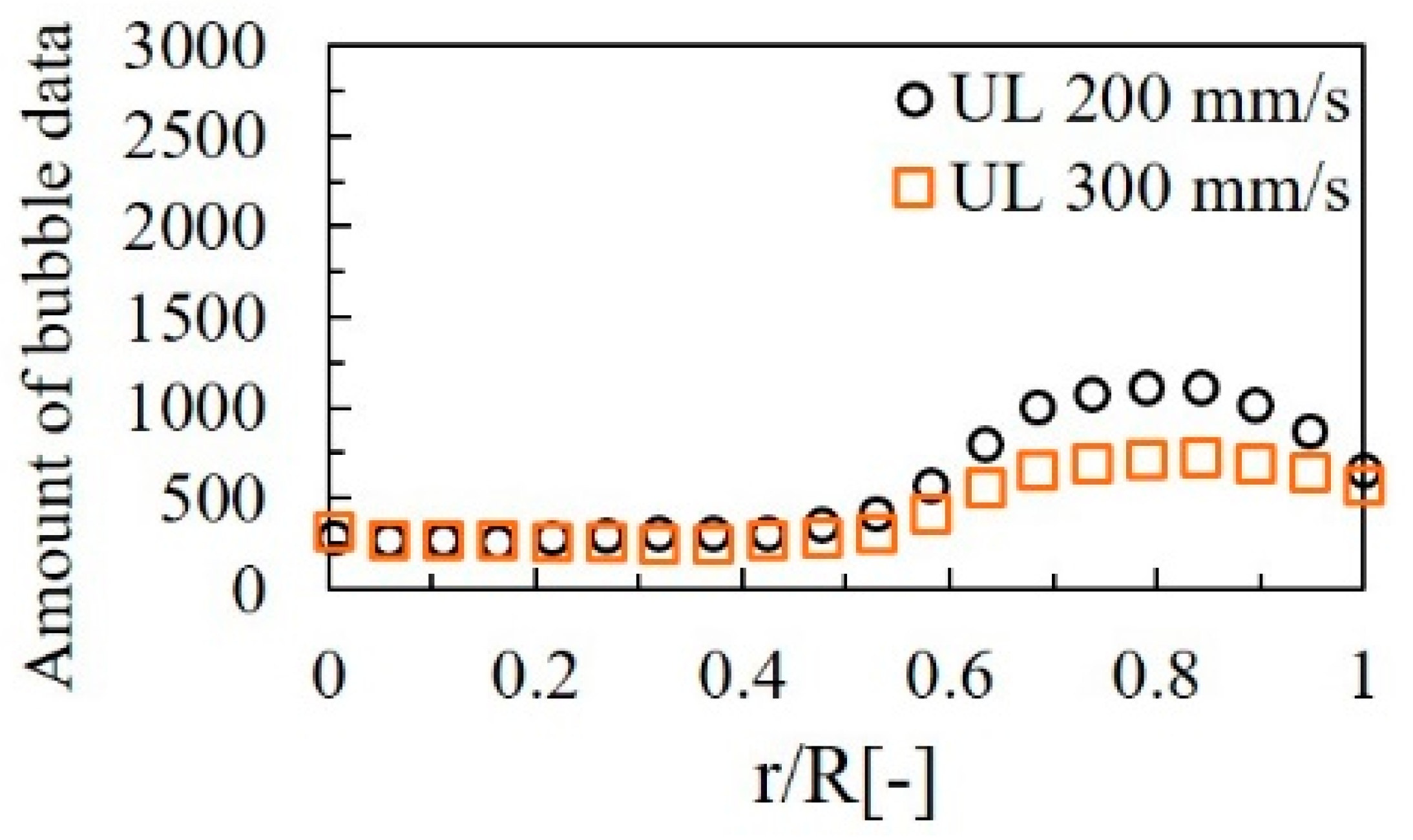
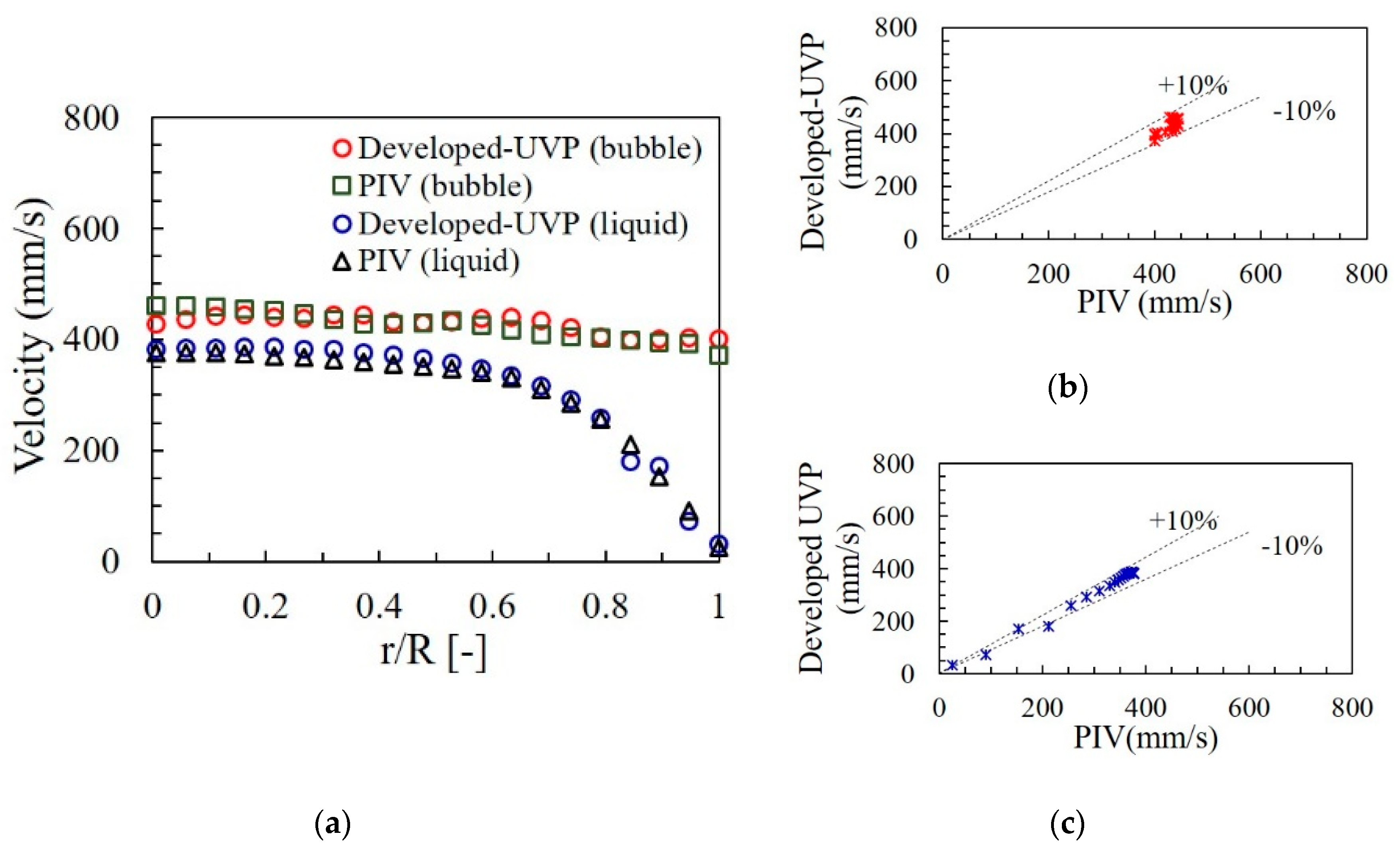
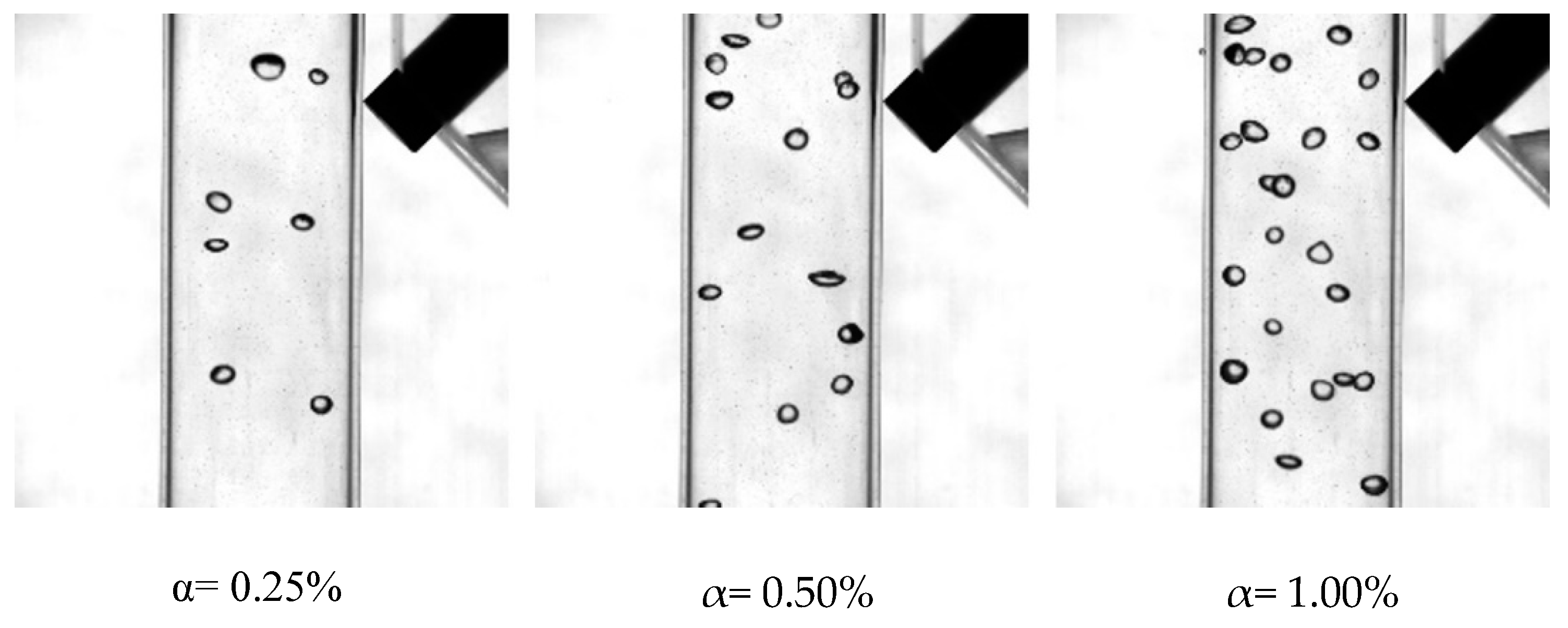
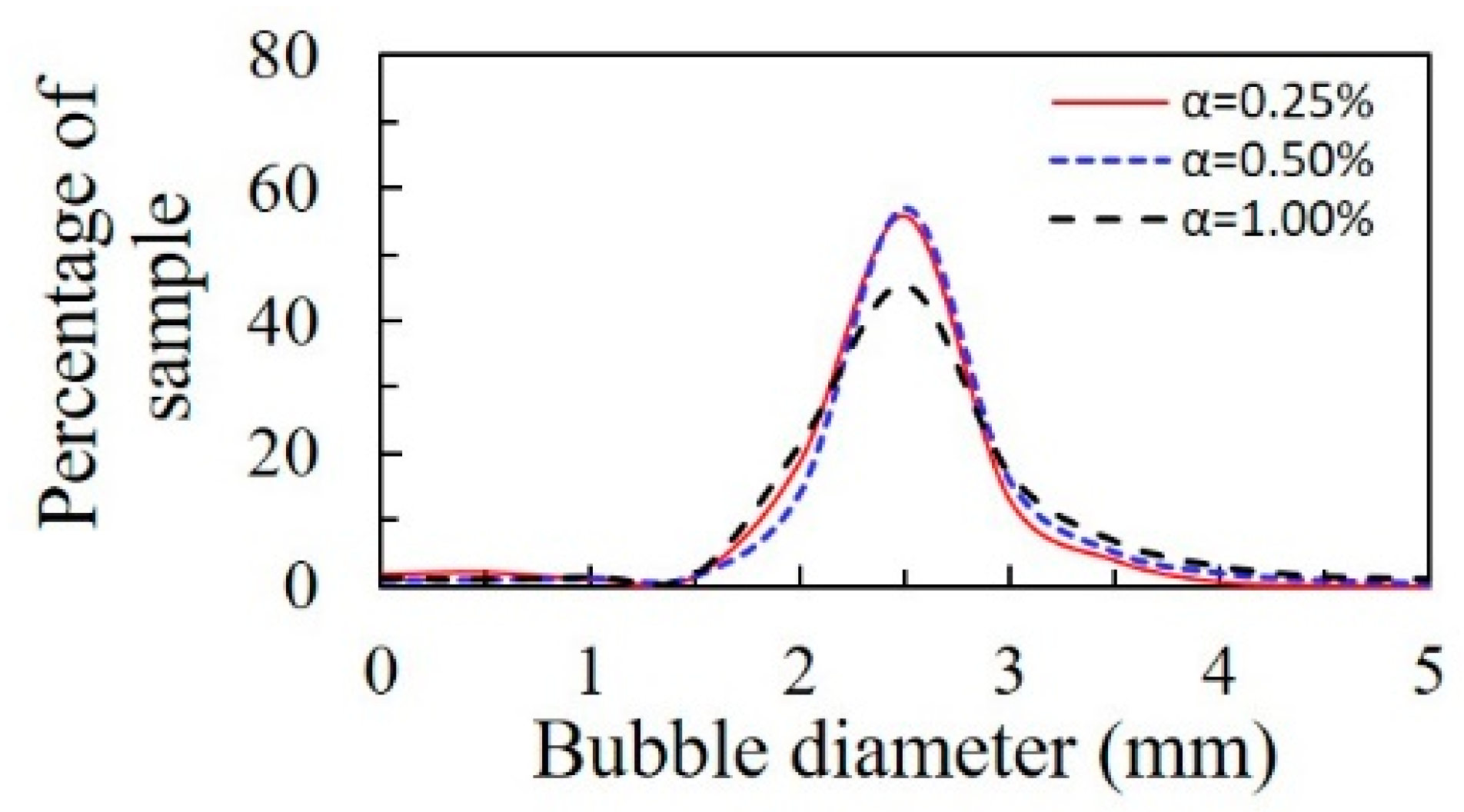
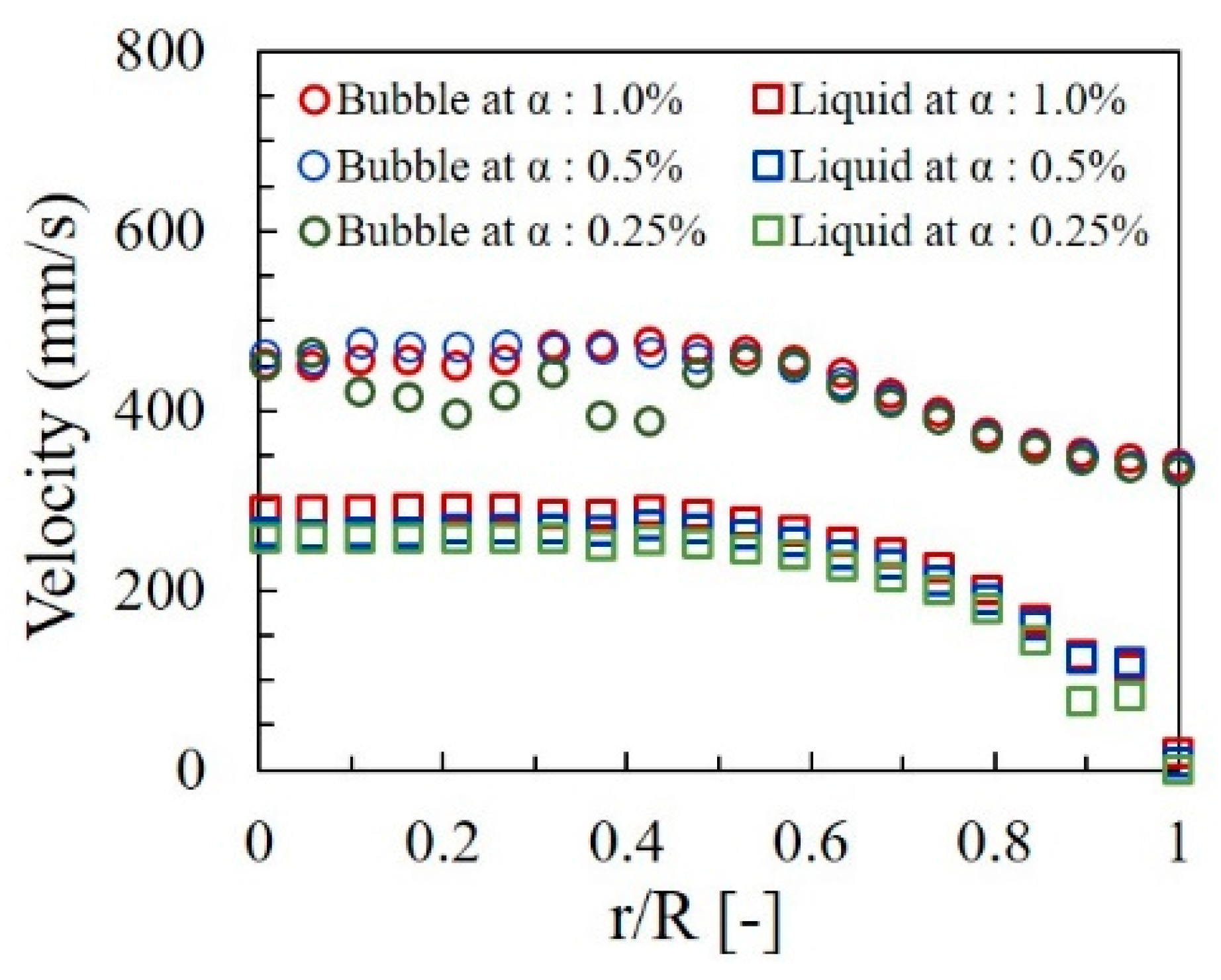
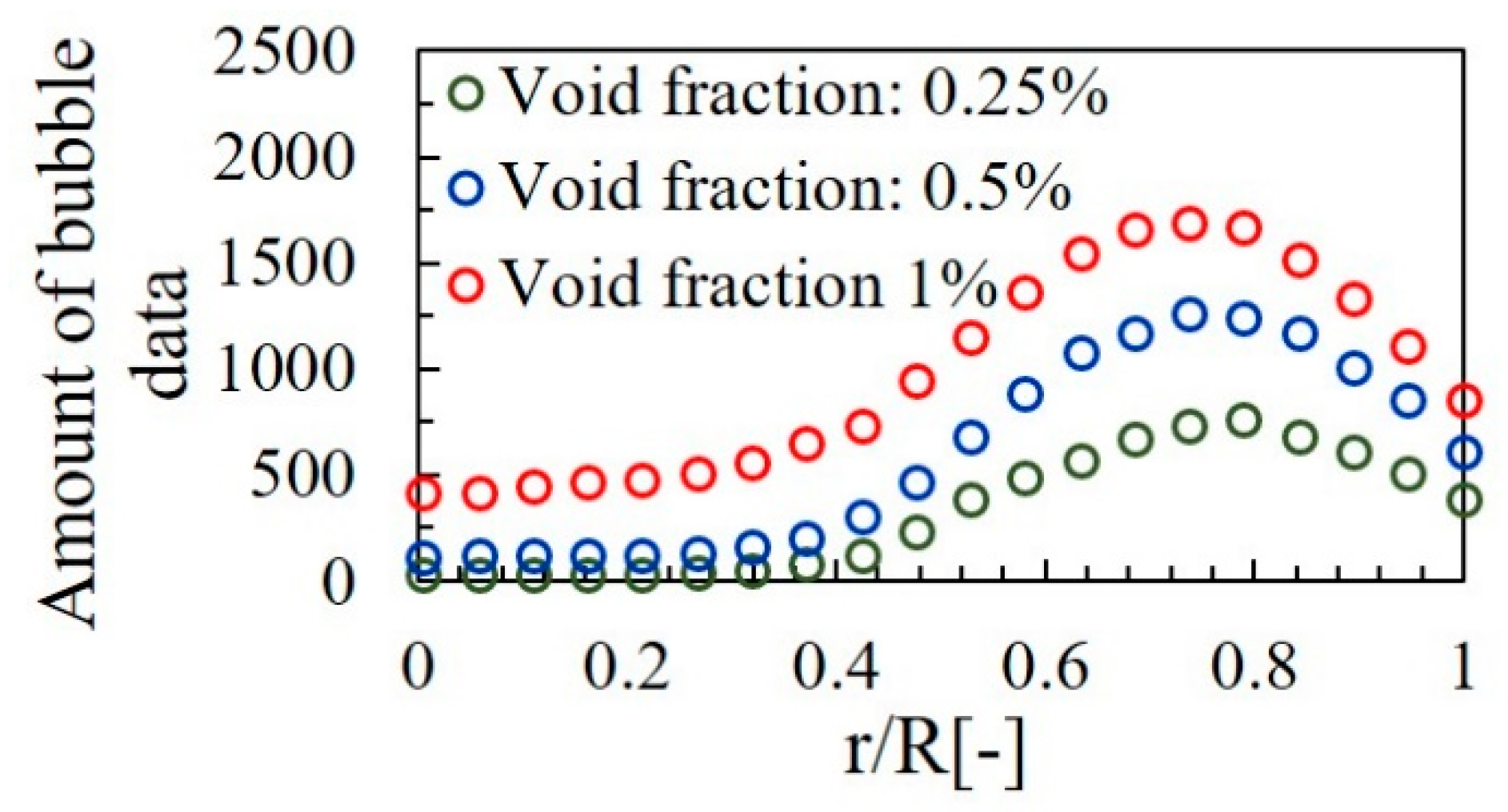
| Method | Readability | Resolution | Computational Time |
|---|---|---|---|
| Short-Time Fourier Transform | Excellent | Good | Excellent |
| Gabor | Excellent | Poor | Poor |
| Wigner–Ville distribution | Poor | Excellent | Good |
| Method | Computational Time (ms) |
|---|---|
| Short-Time Fourier Transform | 0.2657 |
| Gabor | 0.2807 |
| Wigner–Ville distribution | 0.5865 |
| Equipment | Description |
|---|---|
| Transducer | 4 MHz, Model: TX-4-5-8, MFG: Met-Flow, Lausanne, Switzerland |
| Pulser/receiver | Model: RPR-4000, MFG: RITEC, Rhode Island, USA |
| Function generator | Model: AFG-31051, MFG: RSPRO, Northamptonshire, UK |
| Digitizer | Model: NI USB 5133, MFG: National Instrument, Texas, USA |
| Operating software | Model: LabVIEW 2011, MFG: National Instrument, Texas, USA |
| Computer | Model: Vostro, MFG: Dell, Texas, USA |
| Parameter | Value |
|---|---|
| Fluid | Water |
| Fluid temperature | 25 °C ± 2 °C |
| Pressure | 1 atm |
| Sound velocity in water | 1493 m/s at 25 °C |
| Particle | Nylon particles (80 μm) |
| Pipe material | Acrylic resin |
| Pipe diameter | 20 mm |
| Parameter | Value |
|---|---|
| Basic frequency (f0) | 4 MHz |
| Incidence angle (θ) | 45° |
| Emission pulse shape | Gaussian sin |
| Emission voltage | 150 Vp-p |
| Receiving gain | 45 dB |
| Pulse repetition frequency (fPRF) | 8 kHz |
| Number of repetitions (NREP) | 128 |
| Number of cycles per pulse (n) | 4 |
| Channel width (w) | 0.74 mm |
| Parameter | Value |
|---|---|
| Shutter speed | 1:500 s |
| Number of pictures | 16,281 |
| Spatial resolution | 640:480 pixels |
| Method | Cross-correlation |
| Error Sources | Error Magnitude | Percentage of Error |
|---|---|---|
| Basic frequency f0 at 4 MHz of the emitted pulse | ±0.065 MHz | ±1.6% |
| Sound velocity c due to temperature variation (1493 m/s at 25 °C ± 2 °C) | ±10.42 m/s | ±0.69% |
| Incident angle θ at 45° | ±1 degree | ±2.46% |
| Doppler frequency fDi at 4000 Hz (maximum value)(at Sn:1, Wn:24 and fPRF:8 kHz) | ±8 Hz | ±0.2% |
© 2018 by the authors. Licensee MDPI, Basel, Switzerland. This article is an open access article distributed under the terms and conditions of the Creative Commons Attribution (CC BY) license (http://creativecommons.org/licenses/by/4.0/).
Share and Cite
Wongsaroj, W.; Hamdani, A.; Thong-un, N.; Takahashi, H.; Kikura, H. Extended Short-Time Fourier Transform for Ultrasonic Velocity Profiler on Two-Phase Bubbly Flow Using a Single Resonant Frequency. Appl. Sci. 2019, 9, 50. https://doi.org/10.3390/app9010050
Wongsaroj W, Hamdani A, Thong-un N, Takahashi H, Kikura H. Extended Short-Time Fourier Transform for Ultrasonic Velocity Profiler on Two-Phase Bubbly Flow Using a Single Resonant Frequency. Applied Sciences. 2019; 9(1):50. https://doi.org/10.3390/app9010050
Chicago/Turabian StyleWongsaroj, Wongsakorn, Ari Hamdani, Natee Thong-un, Hideharu Takahashi, and Hiroshige Kikura. 2019. "Extended Short-Time Fourier Transform for Ultrasonic Velocity Profiler on Two-Phase Bubbly Flow Using a Single Resonant Frequency" Applied Sciences 9, no. 1: 50. https://doi.org/10.3390/app9010050






